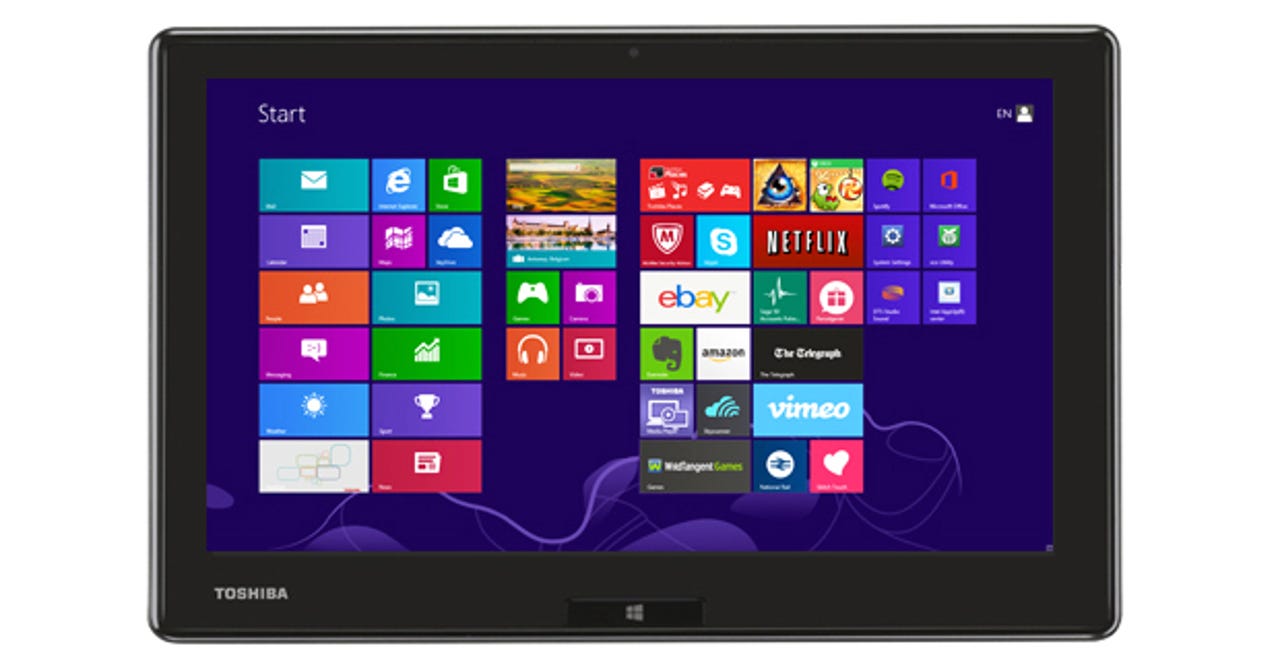Toshiba WT310 tablet: First Take

Toshiba's WT310 is an 11.6-inch Windows 8 Professional tablet aimed at business users, who may be attracted by the system's 128GB SSD. Be aware, though, that our review sample reported just 78GB free out of the box.
The chassis is on the thick side and the weight a little high for our liking: 299mm wide by 189mm deep by 12.4mm thick and 825g isn't far off slimmer, lighter ultrabooks such as Sony's VAIO Pro 13.

The 11.6in. screen has a wide 16:9 format, with a resolution of 1,920 by 1,080 pixels. It's clear enough, and the matte, anti-reflective coating means you can work easily in normal indoor lighting (and even near a window). When you take the WT310 outside, though, it's rather difficult to read in bright sunshine.
The touchscreen has a fingerprint-resistant coating, and in some models is responsive to stylus as well as finger input. The standard stylus is housed in a slot on the chassis; Toshiba also offers a second, fatter and more pen-like, stylus that won't fit in the housing but which we found more comfortable to work with. The top-end WT310-106 model on Toshiba's UK website costs £1,079 (ex. VAT).
The all-plastic build is a bit of a let-down: there's definite give in the casing and movement in the textured backplate too. The slight rim between the screen bezel and outer edges is a little jarring on the eye too, although it doesn't affect usability.
If you're interested in using the Toshiba WT310 for delivering presentations you'll want to know how well the twin speakers on the bottom edge of the chassis perform. Sadly, maximum volume isn't very loud, and sound quality is poor. If you're still keen on the idea of tablet-based presentations, the WT310's support for Intel Wireless Display is some compensation.
A large grille on the top edge and a pair of grilles on the back help cool the processor, whose fan kicks in with alarming frequency and is pretty loud. Working in a quiet office we found it rather distracting. Our review unit, the top-end WT310-106 runs a third-generation Intel Core i5-3439Y processor with 4GB of RAM. This CPU powers three of the four preconfigured options available at Toshiba's UK website, the entry-level model sporting a Celeron processor. The latter costs £619 (ex. VAT) compared to £1,079 (ex. VAT) for the top-end model we were sent.
The bottom edge has a proprietary connector for Toshiba's optional tablet cradle, which costs £50 (ex. VAT) and provides two USB 2.0 ports, HDMI (full-size) and Ethernet ports, an audio jack and a power connector. You could use the USB ports to connect a mouse and/or keyboard.
On the device itself the connectivity options run to Mini-HDMI and (full size) USB 3.0 ports, a full sized SD card slot and headset jack. A button to lock out automatic screen rotation sits between the power switch and a volume rocker. There's a 3-megapixel main camera on the back and a one-megapixel camera on the front.
Toshiba's press release for the W310 mentions optional support for HSPA+/LTE mobile broadband, but this isn't evident in any of the current configurations on Toshiba's UK website. You do get dual-band 802.11a/b/g/n wi-fi and Bluetooth 4.0 as standard though.
Toshiba could have done more to wow us with the WT310, whose build does not feel robust enough to take the rough and tumble of everyday life in a mobile professional's travel bag. As such, it probably isn't the tablet to go for if you're looking to ditch the laptop while on your business travels.